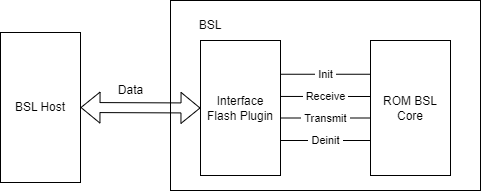SLAU887 February 2023 MSPM0G1105 , MSPM0G1106 , MSPM0G1107 , MSPM0G1505 , MSPM0G1506 , MSPM0G1507 , MSPM0G3105 , MSPM0G3105-Q1 , MSPM0G3106 , MSPM0G3106-Q1 , MSPM0G3107 , MSPM0G3107-Q1 , MSPM0G3505 , MSPM0G3505-Q1 , MSPM0G3506 , MSPM0G3506-Q1 , MSPM0G3507 , MSPM0G3507-Q1 , MSPM0L1105 , MSPM0L1106 , MSPM0L1227 , MSPM0L1227-Q1 , MSPM0L1228 , MSPM0L1228-Q1 , MSPM0L1303 , MSPM0L1304 , MSPM0L1304-Q1 , MSPM0L1305 , MSPM0L1305-Q1 , MSPM0L1306 , MSPM0L1306-Q1 , MSPM0L1343 , MSPM0L1344 , MSPM0L1345 , MSPM0L1346 , MSPM0L2227 , MSPM0L2227-Q1 , MSPM0L2228 , MSPM0L2228-Q1
- Abstract
- Trademarks
- 1Overview of BSL Features
- 2Terminology
- 3BSL Architecture
- 4Bootloader Protocol
- 5Sample Program Flow with Bootloader
- 6Secondary Bootloader
- 7Interface Plug-in
- 8References
- 9Revision History
7.1 Implementation
The Plug-in has to take care of data handling and communication with the BSL Host. This Interface Flash plug-in is coupled with ROM BSL core through the following 4 APIs.
- Init
- Receive
- Transmit
- Deinit
 Figure 7-1 Plug-in Implementation
Figure 7-1 Plug-in ImplementationFlash plug-in image shall be built like any other application and will be loaded to main flash. But unlike application, the startup code or main function will not be executed. Only the above mentioned 4 APIs will be called by the ROM BSL through the hooks registered in the BSL configuration in Non-main memory.